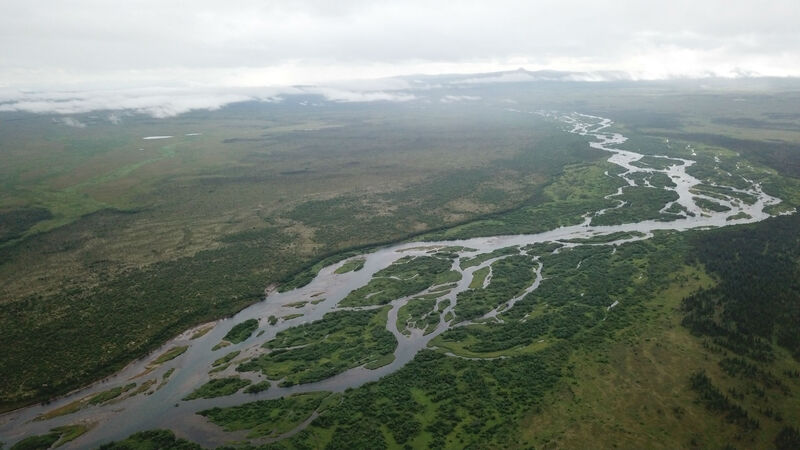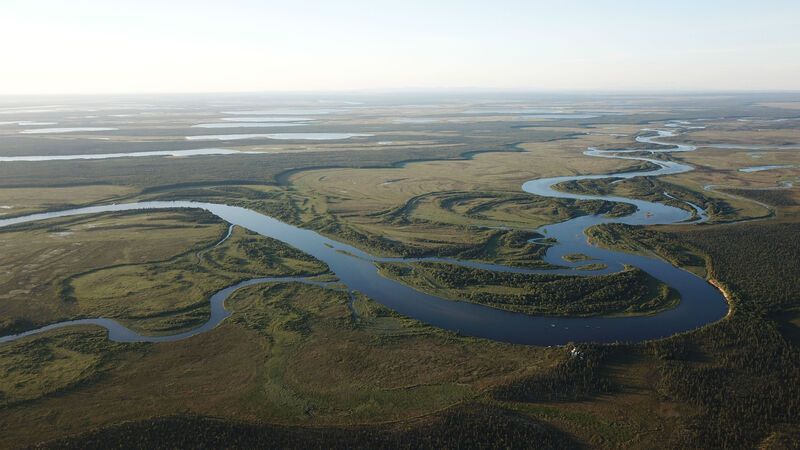|
One of the fabled and enigmatic rivers in Bristol Bay. Few have ever mastered it completely. It takes dedication and love for the river itself. Some guides that work there never leave it. Other guides that do leave, always find a way to come back. The Branch River (known on maps as the Alagnak River) could be clinically diagnosed as suffering from paranoid schizophrenia. To fish it successfully, you must understand its nature and what makes it so fickle.
The origin of the Branch (Alagnak) River is debatable depending on which map you look at. Some maps show the origin as the outlet of Kukaklek Lake. Other maps designate the origin as the confluence of the Kukaklek River and Nonvianuk River. Either way, both rivers are outlets of two very large and deep, natural fresh water lakes with many tributaries feeding them. The vast capacities of booth these lakes give the Branch its almost always clean, clear waters desired by all five species of Pacific Salmon, leopard rainbow trout, arctic char and arctic grayling. Given its agreed upon origin being the outlets of two elephantine sized lakes, these lakes freeze in winter. When the ice begins breaking apart in spring, its descent down river causes catastrophic results. Trees are wiped from the river banks, river banks are sloughed off into the river, temporary ice dams are formed. All this chaos creates new passage ways for the flowing water. New branches of flowing water every year; thus giving the Branch River its local namesake. To operate jet boats in the most heavily braided section of the river is not for the weak or simple minded. It takes constant focus and an ability to read water that doesn’t apply to any other river in the region. In other words, if you don’t know what good water looks like on the Branch, it looks like there is no where to safely go. Rookies crash boats every year. Fact. Aerial Photos of the Alagnak River (Branch River)
Perhaps the most amazing aspect of fishing the Branch is the biblical salmon runs. All five species of pacific salmon use the river as a migration highway. It’s almost continuous gravel bottom with thousands of gravel bars make perfect spawning ground. Sockeye are the first to show up, followed closely by the Kings. Chums arrive next. On even years, Pink Salmon arrive in so many numbers fishing becomes catching. Lastly, the Silvers appear; a favorite of the masses.
While Sockeye rank as one of the highest in table fare, they are not known for their willingness to actually bite when they first enter the river as a freshly sea run fish. When you do hook one, they jump, pull and carry on like a fish twice their size. Kings on the other hand will (and do) bite with aggression. Some anglers believe the Pacific King Salmon to be the greatest of all the sport fish for Spey anglers. The King’s behavior makes it the perfect anadromous fish for swinging flies with a Spey rod. Not to mention an average king weighs in at around 25 pounds with an exceptional fish pushing 40 pounds. They are the King for sure. Chums and Pinks are not regarded highly for table fare, although I have done many shore lunches with both species. As long as they are freshly chrome and handled correctly, they taste wonderful. In addition, both species have this agreeable willingness to bite flies and jigs. This generates high ranks as a sport fish amongst guides and anglers alike. Silvers are arguably held in the most prestige regard of all five species of pacific salmon. Their table fare qualities are as top notch as their sport fish aptitude. Silvers bite eagerly, pull hard and jump in aerobatic cartwheels that would leave Mary Lou Retton in awe. One day fishing for Silvers and it is easy to see why this fish holds the heart of so many anglers. As the freshly chrome ocean run salmon move through the lower river and begin their ascent towards the spawning grounds in the braids, we cease targeting them and change our focus to the rainbow trout that depend on the salmon’s very existence. The circle of life continues as the salmon begin the final phase of the metamorphosis from a saltwater fish to a freshwater spawner. The flesh around their jaws recede and expose a series of teeth previously hidden. The cartilage in their skulls forms a giant kype on the males that looks freakishly jurassic. During this time, the females will accidentally release an egg while trying to pair up for the spawn. On any given gravel bar, you could count hundreds of pre spawn salmon and dozens of rainbow trout sitting behind them anxiously waiting for the random egg to drift by. God help anything that gets in the way of a starved Alaskan rainbow trout seeking salmon eggs for food. Nat Geo never covered anything so brutally raw. As the salmon complete their spawning at the very end of their life cycle, the next facet of our fishing begins. The salmon migrate, go through the metamorphosis, spawn and then die. As they die, their worn down ravaged bodies lodge in rocks, submerged trees, and still themselves on shallow gravel bars. The flesh ripping from their bodies feeding every being that lives in the river. Especially, rainbow trout. Drifting a 7 inch long piece of flesh through the braids behind post spawn and dying salmon is an exhilarating way to hook the fish of a lifetime. The bigger the flesh fly, the better. No flesh fly is too big. Sort of like the sign at Disney World, “you must be this tall to ride this ride.” No flesh fly is discriminated against by any species of salmonid that gorges on it. We are so very fortunate to call this river home waters for our fishing lodge. This river is no doubt one of the best all around rivers in the entire state of Alaska, if not the World. About the Author
Comments are closed.
|
AuthorThe primary contributor, John Perry, is the owner and manager of the lodge. He'll offer fishing summaries and tips too...check back or sign up for the email news to get updates when posted. Archives
November 2023
Categories
All
|
|
|
More News & Info
|
Copyright Angler's Alibi 2019 - All Rights Reserved










 RSS Feed
RSS Feed
